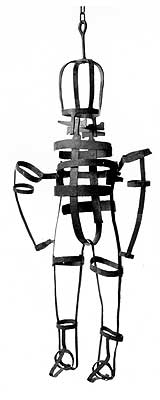The Gibbet

Picture courtesy of the
Atwater Kent Museum
This is arguably the city's most macabre artifact. It's a human form made of iron bands designed to publicly display an executed criminal. The device — more or less — held the rotting corpse together for several weeks. The 18th Century artifact at the Atwater Kent Museum is America's only complete gibbet. A partial gibbet survives in a museum in Salem, Mass. The primary meaning of the word "gibbet" is simply a gallows. The steel frame to display the culprit's body is properly called a "gibbet iron." But there are references to displaying the body as "gibbeting" and soon the steel frame, itself, was also called "a gibbet."
It was a European custom transferred to the New World. Gibbeting was saved for crimes our colonial ancestors considered the most heinous: a wife who murdered her husband, a slave who killed his master or mistress or for pirates.
The Atwater Kent gibbet was made in 1781 to display the body of convicted pirate Thomas Wilkinson. He was to be hung on Windmill Island in the Delaware River off Market Street. (The island was later removed to aid navigation). His body was "to be hung in gibbets" on Mud Island, also known as Fort Mifflin. Probably Mud Island was selected so sailors on passing ships might be warned of the consequences of piracy. In 1780, Wilkinson and an accomplice seized "the prize ship, Richmond" by force in the port of Philadelphia and sailed it to Charleston, then in British hands. But Wilkinson escaped the gallows and gibbeting after a surprisingly large number of important and influential Philadelphians sign a petition asking mercy for the pirate. The hanging was postponed, and it appears that Wilkinson's life was spared. But his gibbet iron was already made and paid for by the state. It was stored in the old Walnut Street Prison then hung as a warning to prisoners in Moyamensing Prison. It was transferred to the Atwater Kent Museum in the 1940s. The gibbet is now on display at the museum.



